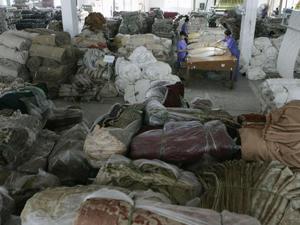SAN FRANCISCO - U.S. and Chinese officials began two days of trade talks on Tuesday that American manufacturing groups hope will lead to limits on surging textile imports from China.
Import groups and retailers say tough limits could drive up clothing costs for U.S. consumers, but U.S. textile manufacturers want a deal to protect an industry roiled by imports from China since a decades-old global quota system expired on Jan. 1.
Since then, the Bush administration has blocked billions of dollars of shirts, pants and other clothing under a special textile “safeguard” provision that China accepted when it joined the World Trade Organization in 2001.
The talks in San Francisco come as part of the normal consultations required under WTO rules whenever a member country imposes safeguard curbs.
The Bush administration is also expected to make a decision by the end of this month on requests for additional restrictions on other categories.
But U.S. textile groups and lawmakers have pressed the White House for a comprehensive deal that would restrict clothing imports from China through 2008, when the safeguard mechanism expires.
Currently, the U.S. has imposed quotas on a number of clothing categories that limit growth to 7.5 percent a year -- a rate U.S. textile manufactures would like to see in a final deal.
“Stability and Predictability”
Missy Branson, a spokeswoman for the National Council of Textile Organization, said she expects these talks will likely provide a framework for later negotiations.
She called for a deal that would safeguard U.S. textile manufacturers from less expensive Chinese products.
“At best we could hope for a general framework that comes out of these talks,” she said. “We need stability and predicability so we know we are not going to get 1,000 percent surges while waiting for safeguards.”
The negotiations follow a recent European Union deal with China that goes through the end of 2007 and allows for annual growth rates of 8 percent to 12.5 percent.
China rejected the idea of a comprehensive textile trade agreement last year but might now be more willing to sign a deal with the United States following its agreement with the EU.
U.S. importers favor a pact that would allow for at least 20 percent to 25 percent growth in annual quotas rather than the lower limit U.S. textile groups want, said Laura Jones, executive director of the United States Association of Importers of Textiles and Apparel.
“We would like to see some kind of agreement so there will be certainty when people place their orders they will get their goods,” she said. “The base level of 7.5 percent is nothing and you need to address the realities of the potential of the Chinese market.”
